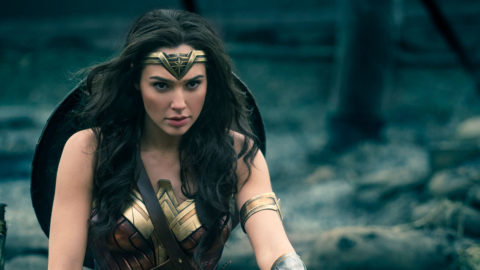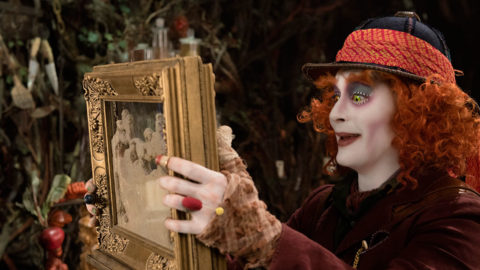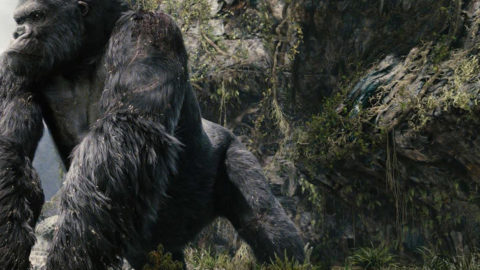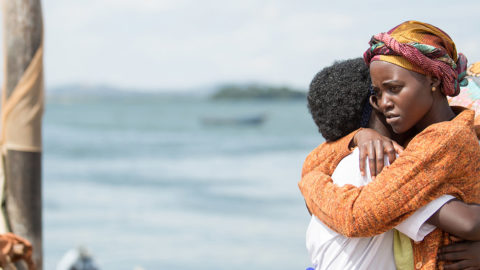Deep Focus: Tomb Raider
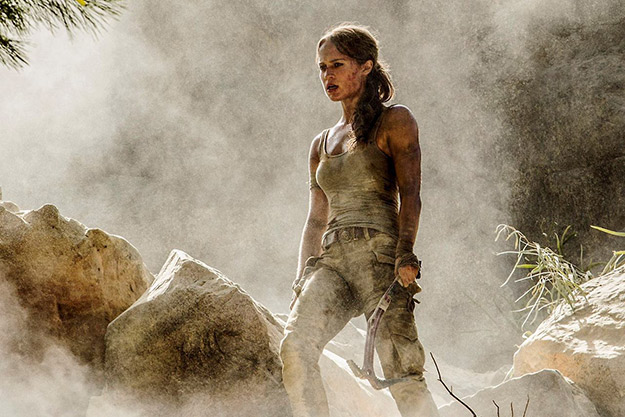
If the hero of this rebooted franchise were a boy, he’d be nicknamed “Chip,” as in “chip off the old block.” Instead, Lord Richard Croft (Dominic West) affectionately calls his daughter Lara (Alicia Vikander) “Sprout,” as in “a young shoot (as from a seed or root).”
Could she have lived up to a more vivacious moniker, like, say, “Sprite?” Maybe not. The filmmakers and Vikander devote themselves to bringing the glitzy “cyberbabe” of the original video games and two Angelina Jolie movies back to earth. And down she goes, with a thud. I was not a big fan of the first Jolie film, Lara Croft: Tomb Raider (2001), but in Lara Croft: Tomb Raider—The Cradle of Life (2003), the star’s mix of campiness and gusto proved infectious: she was more fun than all three big-screen Charlie’s Angels rolled into one. Vikander’s Lara, on the other hand, is the “woke” equivalent of a tomboy with interests in cycling and kickboxing. Men neither poke fun at nor ogle her. When she becomes the “fox” in a “fox hunt,” there’s no innuendo—she’s just the symbolic prey in a bike contest. If she eludes capture, the prize money will pay her back rent.
We meet her as a 21-year-old bike courier in East London. Her adored father went missing during a trip to Japan seven years earlier. As an act of rebellion against her aristocratic past and allegiance to her dear old dad, she lives hand-to-mouth, refusing to sign papers that would certify her acceptance of his death and her inheritance of Croft Holdings.
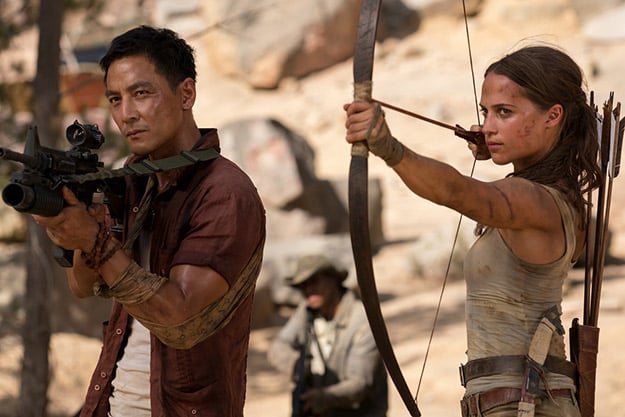
Just when Croft corporate honcho Ana Miller (Kristin Scott Thomas), Lara’s former guardian, nudges her toward the dotted line, she discovers a mind-blowing message from her father that reveals his secret life as a daredevil archeologist. It sends her scurrying to Hong Kong and then onto the remote Japanese island of Yamatai, convinced that he’s still alive and pursuing the tomb of Queen Himiko—also known as the Mother of Death.
Some unfunny things happen on the way to the tomb. She acquires a gruff but loyal seaman sidekick, Lu Ren (Daniel Wu), whose own father disappeared with Lord Richard. She also gets an arch-villain, Mathias Vogel (Walton Goggins), who is trying to recover Himiko’s remains—and its world-threatening supernatural powers—for an evil association named Trinity.
These supporting parts are as crumbly as Styrofoam. Unlike Jolie’s movies, which supplied Lara with a gadget-master and a lethal comic butler as well as past lovers and frenemies, this film is basically a one-woman show. And I do mean one woman. For at least half of the running time, she’s the only gal onscreen. “Do you want more female faces onscreen, period?” screenwriter Geneva Robertson-Dworet rhetorically asked New York Times reporter Robert Ito. “Or is it better for the character journey that she’s in this very threatening, all-male world?” I would have voted for more women. The only time this Lara seems totally at ease is when she’s joshing in one scene with a fellow female gym rat.
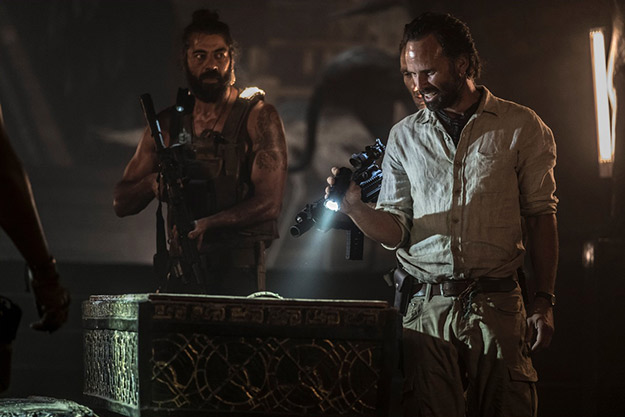
Is Vikander up for the challenge of a one-woman show? Physically, the answer is a resounding yes. She studied ballet until injuries ended her dancing dreams. For Tomb Raider, she put eight-pack abs on her sylph-like frame and beautifully calibrated guns on her slender arms. As a crackerjack archer and a breakaway runner, she could take top prize at a “Bow ’N’ Go” triathlon. No question, Vikander goes all-in as an actor-athlete. Unlike Jolie, who kept an amusing, preternatural aplomb, she makes the choice always to let us see her sweat. Her performance is an exercise in…exercise. She pants, she groans, and she very occasionally yelps. She has a few sly moments, almost all in London, especially with a lovesick restaurant worker (Antonio Aakeel) and a sleazy pawnbroker (Nick Frost). She convincingly expresses mixtures of love and anger with her father, but it’s impossible for her and West to conjure a relationship with nothing more to work on than that oft-repeated “Sprout” and kisses thrown with just two fingers (their signature farewell).
Otherwise, she’s all business—and all business and no play makes Lara a dull girl.
As much as any person could, I enjoyed watching Vikander run through the jungle. Norwegian director Roar Uthaug does his best and most distinctive work when he’s focusing on her corded arms and back muscles as she pounds away in the rainforest. But there’s little he can do with Robertson-Dworet and Alastair Siddons’s script (derived largely from the “third era” of the video game), which functions like a treasure map without resonance or mystery.
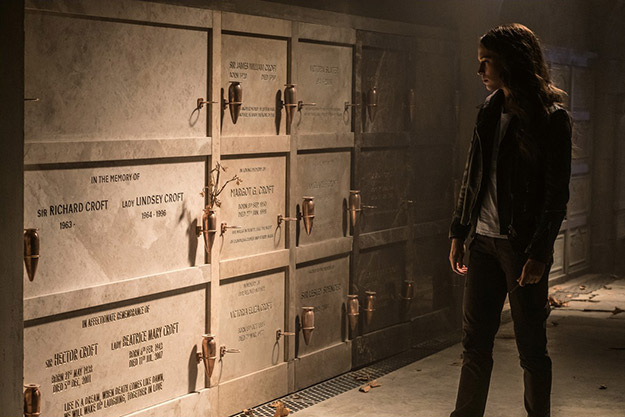
The way they set up the action, it’s as if Lara is part Road Runner and part Coyote. Her Road Runner side blithely dashes into danger zones, but her Coyote side suffers the consequences. When Lara leaps from Lu Ren’s ruined ship, the Endurance, or grabs hold of a deteriorating World War II plane perched over a waterfall, she’s buffeted by the wreckage of the hull and the fuselage. I expected to see “Acme Corporation” stamped all over it.
She charges her enemies without a game plan, so she shouldn’t act so surprised when they punish her mercilessly. It’s one thing to intensify the melodrama by highlighting Lara’s vulnerability. It’s another to turn fight scenes into silly symphonies of “ooofffs” and “uhhhhsss.” I did get a charge out of the idea that the second or third best female kickboxer in an East London gym would be competitive in fights with Vogel and his muscle-bound thugs. But it wouldn’t have been a stretch for Uthaug to decorate his images with balloons containing comic-book fight sounds, like “Wham!” and “Pow!” It might have even brought down the house.
Uthaug has bet the movie on getting the audience to identify with Lara, so he’s tossed away the clarity and sense of place that made his disaster movie The Wave (2015) so effective. In Tomb Raider, as in the video game, we follow the action from Lara’s point of view. In the shipwreck scene, the winds and foam and nautical remains swirl and thrash all around her. When she suddenly spots and grabs a parachute on that old bomber, we’re just along for the ride. The director kills the chance for Hitchcockian suspense, because he doesn’t lay out the elements of the scene before they come into play. He doesn’t get us thinking, from the time she boards the plane, “She’ll get away only if she grabs that parachute.” In a video game, played over and over again, suspense builds as you get to know the geography.

Here all we can react to is Vikander’s trim athleticism. The film has been hailed for its divergence from the voluptuous sexual stereotyping that Jolie actually toyed with, exuberantly. Lara Croft: Tomb Raider hinted at amorous escapades and Lara Croft: Tomb Raider —The Cradle of Life hinged on Lara’s trust in the professional skills of a past lover. There’s nothing like that in this movie, where even the title is stripped down to Tomb Raider.
How much of a blow can this movie be to patriarchy of any kind when this Lara’s heart belongs solely to daddy?
Michael Sragow is a contributing editor to Film Comment and writes its Deep Focus column. He is a member of the National Society of Film Critics and the Los Angeles Film Critics Association, and a programmer at the Criterion Collection.



